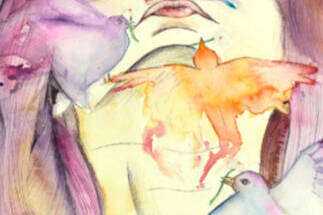Portfolio Prep
- Students develop a comprehensive portfolio for applying to art schools and colleges. Through a two-year sequence of alternating projects, each student enrolled in Portfolio Preparation will complete a substantial body of work for his/her portfolio.
- Students wishing to finalize their college portfolio in Art may do so in their senior year with Portfolio Preparation, or the more rigorous AP course.
- All projects involve developing ideas through careful planning, thoughtful discussions and critiques. They are also expected to visit museums/galleries and keep an ongoing journal as they experience the artwork they see, responding critically and artistically, through reflection and artistic experimentation.
- Below are few sample of portfolio preparation requirements, which may vary depending on your major and your school.

AP Studio Art
- AP Studio Art is a series of Advanced Placement Courses divided into three different categories: AP Studio Art Drawing, AP Studio Art 2D Design, and AP Studio Art 3D Design.
- AP Studio Art is a one-credit course intended for the serious 12th grade art student who is highly self-motivated and committed to building a superior portfolio.
- The course is time-demanding and based on quality, concentration on a particular mode of work, and breadth of experience. Students will submit their portfolios for evaluation to The College Board enabling them to qualify for college credit in studio art.
- Students must choose to submit either a 2D, 3D, or Drawing Portfolio.
- To qualify for entrance into the AP, students must maintain a high average in their junior year and undergo a Department Portfolio review.
- It is strongly recommended that entrants pursue guided work during the summer of their junior year, in order to prepare for the AP. Completion of a summer assignment is required for all students who wish to qualify.
Interior Design
Art portfolios are NOT required for Interior Design majors, but they may do so if they wish to demonstrate their drawing or design skills. Success as an Interior Designer can be independent of the natural ability to draw; however, the ability to think critically and collaborate is essential. Therefore, we recommend that you complete two exercises to assess your critical thinking and collaboration abilities.
Submit these as your portfolio:
- Describe a collaborative project that you have worked
- Critique a learning space that you experienced (school, worship or community center, library, shopping mall, etc.)
Photos or sketches may be submitted as well as links to social media accounts.
Illustration
Be sure to show lots of examples of drawing from life and direct observation, such as:
- Hands, feet, human figures and animals
- Representational drawing
- Interior and/or exterior environments
- Class assignments, design projects
- Animation, multimedia
- Paintings, photographs, and/or sculptures
- Do not copy from another artist.
- Avoid cliches like anime, tattoo designs, dragons, or unicorns
- At least half of your portfolio should consist of drawing from direct observation.
Fine Arts
Your portfolio is reviewed with your chosen major in mind. You may incorporate any or all of the following in your portfolio:
- Design projects or class projects
- Logo designs, posters
- Website or mobile site designs
- Photography, film, multimedia projects
- Paintings, drawings, sculptures
- Concept sketches for your cool ideas
- Samples of your writing
Work may be created by hand or digitally and should demonstrate diversity of style and strong sense of overall composition, regardless of medium. Make sure all of your work is original!
Computer Animation
Be sure to show lots of examples of drawing from life and direct observation, such as:
- Hands, feet, human figures and animals
- Representational drawing
- Interior and/or exterior environments
You can also include:
- Class assignments, design projects
- Animation, multimedia
- Paintings, photographs, and/or sculptures
Important to remember:
- Do not copy from another artist.
- Avoid cliches like anime, tattoo designs, dragons, or unicorns
- At least half of your portfolio should consist of drawing from direct observation.






